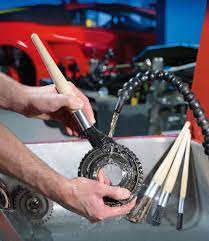Are parts cleaning brush you tired of struggling to clean those hard-to-reach areas in your machinery and equipment? Do stubborn grime and dirt buildup cause frequent breakdowns or performance issues? Well, you’re not alone. But don’t worry, there’s a solution that will make your life much easier – the parts cleaning brush! In this blog post, we’ll explore everything you need to know about these handy tools and how they can help keep your equipment running smoothly. So let’s dive in!
What is parts cleaning brush?
A parts cleaning brush is a type of brush designed specifically for cleaning small parts and components. Parts cleaning brushes are made from a variety of materials, including nylon, stainless steel, and brass. They are available in a variety of sizes and shapes to accommodate different types of parts and components. Parts cleaning brushes are used to remove dirt, debris, and other contaminants from parts and components. They can also be used to apply cleaners, polishes, and other chemicals to parts and components.
Different types of parts cleaning brushes
There are many different types of parts cleaning brushes that are available on the market. Each type of brush has its own unique set of features and benefits that make it ideal for use in a specific application. Here is a brief overview of some of the most popular types of parts cleaning brushes:
1. Nylon bristles – Nylon bristles are soft and flexible, making them ideal for delicate surfaces. They are also resistant to most chemicals, making them a good choice for use in parts cleaning solutions.
2. Stainless steel bristles – Stainless steel bristles are much stiffer than nylon bristles, making them ideal for scrubbing tough surfaces. They are also resistant to rust and corrosion, making them a good choice for wet or dry applications.
3. Natural fibers – Natural fiber brushes (such as hog hair or horsehair) are very soft, making them ideal for sensitive surfaces. However, they are not as durable as nylon or stainless steel bristles and will break down over time if used excessively.
4. Synthetic fibers – Synthetic fiber brushes (such as polyester or nylon) offer the same benefits as natural fiber brushes but are more durable and resistant to breakdowns. They are also often less expensive than natural fiber brushes.
Pros and cons of using a parts cleaning brush
When it comes to parts cleaning, there are a number of different methods that can be used. One popular method is using a parts cleaning brush. There are both pros and cons to using this type of brush for cleaning parts.
The biggest pro of using a parts cleaning brush is that it can reach into small spaces and crevices that other methods may not be able to reach. This can be helpful when trying to clean hard-to-reach areas or delicate parts. Another benefit is that brushes are relatively inexpensive and easy to find.
There are also some cons to consider when using brushes for parts cleaning. One downside is that they can be difficult to control, making it easy to damage delicate parts. In addition, brushes can leave behind debris and remnants of the cleaner, which may need to be removed before painting or coating the part.
How to use a parts cleaning brush
A parts cleaning brush is a tool that is used to clean small parts and components. It is typically made of nylon or stainless steel bristles and can be found in a variety of sizes.
When using a parts cleaning brush, it is important to first identify the type of material that the bristles are made of. This will determine the best way to clean the brush. For example, nylon bristles can be cleaned with soap and water, while stainless steel bristles may require a more abrasive cleaner.
Once the type of bristle has been determined, the next step is to select the appropriate cleaning solution. If cleaning with soap and water, be sure to use a mild detergent so as not to damage the bristles. For more stubborn dirt and grime, a stronger cleaner may be necessary. Always follow the manufacturer’s instructions when using cleaners on parts cleaning brushes.
After the cleaning solution has been selected, it is time to start scrubbing! Begin by wetting the bristles of the brush in the solution and then applying pressure to the surface being cleaned. Use circular motions for best results. Continue scrubbing until all dirt and grime have been removed from the surface.
Finally, rinse off the brush with clean water and allow it to air dry before storing it away.
Conclusion
Parts cleaning brushes are an invaluable tool for any workshop or home garage. They help you quickly and safely clean parts of all shapes and sizes, saving time, energy and money in the process. With a little experimentation you can find the perfect brush for your job that will make it easier to keep your tools working their best. So if you’re looking for a simple way to keep your workspace tidy, don’t overlook this handy tool – they just might be what you need!



